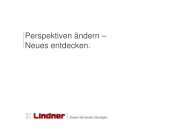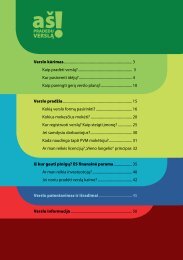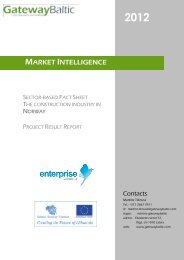Safety Time - Versli Lietuva
Safety Time - Versli Lietuva
Safety Time - Versli Lietuva
Create successful ePaper yourself
Turn your PDF publications into a flip-book with our unique Google optimized e-Paper software.
Keynote Speaker: John L. Thompson
Exponential Growth: Kreisler Manufacturing, Inc.<br />
Exponent Growth Strategy: Create surplus capacity using TOC and then sell this as Reliable Rapid Response on<br />
48 hour turn around to major clients at prices related to lead time performance demand.<br />
Summary from a slide presentation given by the Management of Kreisler Manufacturing Corp.<br />
TOC Upgrade Memphis TN – 1999.<br />
Company<br />
� Sales $13 million<br />
� Employees 100<br />
� Facility 52,000 sq/ft<br />
� Customers<br />
�Pratt & Whitney<br />
�GE Aircraft Engines<br />
�Rolls Royce<br />
�Mitsubishi Heavy Ind<br />
14<br />
12<br />
10<br />
8<br />
6<br />
4<br />
2<br />
0<br />
Revenue<br />
19 9 4 19 9 5 1996 1997 1 9 98<br />
Delivery Performance<br />
� Sales up 128% in two years<br />
� Delivery up from 65% to<br />
95% in two years<br />
� Capacity 12 months ahead<br />
of competition<br />
100%<br />
75%<br />
50%<br />
25%<br />
0%<br />
Nov-96 May-97 Nov-97 May-98<br />
Products<br />
� Products<br />
�Tube and manifold<br />
assemblies<br />
�Sheet metal baffles<br />
�Complex welded<br />
fabrications<br />
�Hot formed titanium<br />
components<br />
� Processes<br />
�Brazing and welding<br />
�Heat treating<br />
�Non-Destructive testing<br />
$60<br />
$50<br />
$40<br />
$30<br />
$20<br />
$10<br />
$0<br />
2.63<br />
Growth plus Stability<br />
Kreisler Stock Price<br />
5.00<br />
8.00<br />
23.50<br />
©Global Focus LLC. Jan2008<br />
TOC Productivity<br />
� T/OE<br />
� Throughput<br />
�Net Sales<br />
�Materials<br />
�Overtime<br />
� Operating Expense<br />
�Overhead<br />
�Direct Labor<br />
�SGA<br />
52.00<br />
Aug 96 Aug 97 Aug 97 Sep 97 Nov 97<br />
1.50<br />
1.00<br />
0.50<br />
0.00<br />
0.70<br />
0.59<br />
0.77<br />
1.12<br />
1.30<br />
1994 1995 1996 1997 1998<br />
Introduced TOC<br />
Fasten your seat belts<br />
William Green, 12.15.97<br />
FORBES MagazineDecember 1997.<br />
Kreisler hit $53.88 on Nov. 12 and is now<br />
trading at $52. That’s a 1,880% increase in a<br />
little less than 15 months.<br />
Global Focus LLC<br />
John L. Thompson<br />
Global Focus LLC<br />
USA 203 376 3575<br />
JohnT@GlobalFocusllc.com
600 Young Street • Tonawanda, NY 14150 • Phone 800.654.6360 Fax 716.693.5854<br />
SR Instruments, Inc. has been providing solutions for 30 years. As an ISO 9002 certified company, SR Instruments has been manufacturing quality sensors<br />
and instrumentation for the medical, land and marine animal, and sailboat industries worldwide.<br />
SR Scales utilizes expertise in load cell design and manufacturing making the company a leader in the industry for the development of highly specialized,<br />
precision scale systems. SR Scales offers a complete line of scales from pediatric to bariatric, as well as applies this same advanced precision technology to<br />
the veterinary, marine, and zoological community.<br />
IMPLEMENTATION RESULTS<br />
Revenue Increase 83%<br />
Inventory to Sales reduction 50%<br />
Expenses Stayed Flat<br />
Net Profit Increased 130%<br />
PROJECT PAYBACK Months to first visible results<br />
Strategy and Application:<br />
All the Theory of Constraint Applications:<br />
Market Segmentation, Production and Distribution.<br />
©Global Focus LLC WWW.GolbalFocusllc.com<br />
OTHER BENEFITS<br />
On-time performance<br />
From 5 days late to 95% OTD<br />
Lead times From 8 Weeks to 48 Hours any destination<br />
Global Focus LLC<br />
John L. Thompson<br />
Global Focus LLC<br />
USA 203 376 3575<br />
JohnT@GlobalFocusllc.com
Sales<br />
$10M<br />
Distribution<br />
Cooling Towers Offer<br />
Sept 11<br />
DBR DBR<br />
$22M<br />
$16M<br />
$21M<br />
500, Inc 2008<br />
Fastest Growing<br />
Private Companies<br />
$32M<br />
Full Strategy<br />
$43M<br />
1996 1998 2000 2004 2006 2007 2008<br />
2009<br />
$50M
Using TOC to focus LEAN and build competitiveness<br />
Strategy and Tactics:<br />
Dealing with Variance begins at the top with Corporate Strategy<br />
Ensure that the operational capability exceeds the demand:<br />
Learn how the logistical solutions combine<br />
Operations, Projects and Distribution<br />
Is it worth the effort?<br />
Calculating the value of released capacity<br />
Increasing project velocity<br />
Selling the additional Capacity:<br />
Analyze appropriate Markets<br />
Constructing an Unrefusable Offer<br />
Sell the Offer to select Customers<br />
Execution:<br />
Use Critical Chain Project Management<br />
to implement the Business Plan
Testing the Organizational Will to Commit?<br />
An Organization is typically in one of three states of mind:<br />
Ambitious And possibly “frustrated” by having “missed opportunities”.<br />
An intolerance for mediocrity.<br />
Complacent “Life is Good” – curious and possibly ready to listen,<br />
but not willing to move to action. Opportunity blindness.<br />
Crisis If this does not work - “it’s possibly our end”.<br />
This also applies to Departments, mainly due to the silo’ed reward system.<br />
© Global Focus LLC<br />
All rights Reserved.
The Importance of Ambition<br />
Small or large investments require the same amount of effort, so concentrate<br />
on large investments.<br />
Stretching Goals elevates purpose:<br />
Reduces the Decision Options:<br />
• The higher the goal – the fewer the options there are to achieving it.<br />
Reduces Introspective Behaviors (Blaming others):<br />
• Teams are too busy engaged in change to blame each other for daily<br />
frustrations.<br />
Removes the Silo effect<br />
• There is no option but to work together if the Goal is large enough.<br />
Fosters Collaboration (counters lack of purpose and mediocrity):<br />
• Meaningful Goals harness collaboration.
Opportunity and Variation Starts at the Top<br />
Level of influence Methodologies Focus<br />
Strategy<br />
Induced Variation<br />
Management<br />
Induced Variation<br />
Demand / Vendor<br />
Induced Variation<br />
Supervisor<br />
Induced Variation<br />
Process<br />
Induced Variation<br />
Operator /<br />
Technician<br />
induced Variation<br />
LEAN<br />
Eliminate Waste,<br />
Decrease product<br />
cycle time<br />
What is not<br />
adding value?<br />
What blocks<br />
more Goal units ?<br />
TOC<br />
Maximize<br />
System Value<br />
(Throughput Velocity)<br />
6 Sigma<br />
Remove Defects,<br />
Minimize<br />
Operational<br />
Variation<br />
What is causing<br />
variation?<br />
Global Objectives<br />
Redefined<br />
Division/Department<br />
Objectives Realigned<br />
Exploiting / Elevating<br />
External Constraints<br />
Realigning<br />
Local Activity<br />
with<br />
Global Objectives<br />
Local Activity:<br />
(balanced capacity<br />
trap = Increased<br />
Dependency, Local<br />
Optimization)
Strategy and Tactics<br />
Traditional S&T Vs.<br />
TOC S&T<br />
Strategy<br />
? ?<br />
Tactics Tactics Tactics<br />
Middle Management<br />
Interpretation<br />
and Execution<br />
Strategy<br />
Tactics<br />
Strategy<br />
Tactics<br />
Strategy<br />
Tactics<br />
Strategy<br />
Tactics<br />
Strategy<br />
Tactics<br />
Strategy<br />
Tactics<br />
Strategy<br />
Tactics
Significant Vision<br />
Verify<br />
Opportunity<br />
Delivery<br />
System<br />
Architecture<br />
Applications<br />
Execution<br />
Tame<br />
Input<br />
0.0 Generic Strategy and Tactic Map ©Global Focus LLC<br />
Choke<br />
Release<br />
Install<br />
Buffers<br />
Active<br />
BM<br />
4.0<br />
Maximize<br />
Flow<br />
Priority<br />
System<br />
BM<br />
Dianose<br />
3.0<br />
Build a System<br />
POOGI<br />
Elevate<br />
Capacity<br />
2.0<br />
Select a URO<br />
4.1<br />
Measurements<br />
Align<br />
Rewards<br />
Monitor<br />
Segment<br />
3.1<br />
Capitalize<br />
4.2<br />
S & M<br />
Sales<br />
Cycle<br />
©Global Focus LLC<br />
1.0<br />
Ambition & Value<br />
Target<br />
Prospects<br />
3.2<br />
Maintain<br />
4.3<br />
Pipeline<br />
Customize<br />
Offers<br />
Feedback<br />
Monitor<br />
Emerging<br />
Constraints<br />
2.1<br />
Exploit the URO<br />
4.4<br />
Elevate<br />
capacity<br />
Justify<br />
Elevation<br />
3.3<br />
Grow<br />
4.5<br />
New Market<br />
Segments<br />
Selection<br />
of new<br />
Markets<br />
10<br />
Develop<br />
Sales Cycle
Stability and Growth<br />
©Global Focus LLC 2000
Growth<br />
&<br />
Stability<br />
Growth and Stability Dilemma<br />
Assumption: Growth Produces Value?<br />
Bold<br />
Strategic<br />
Initiatives<br />
Maintain &<br />
Develop<br />
Processes<br />
Focus<br />
resources on<br />
bold Strategy<br />
Solution: Develop Management at all levels<br />
Focus on<br />
incremental<br />
change<br />
Assumption: Growth and Stability are mutually exclusive?<br />
However, the eventual constraint to growth is insufficient Management.
Leadership: Responsible for the coordination of Growth plus Stability<br />
Need for<br />
Stability<br />
Security<br />
Pragmatic<br />
Preservation<br />
Leadership<br />
Co-ordination Bridge<br />
Peeling Layers of Security 1, 2, 3, 4, 5, 6, 7, 8.<br />
Communicate & Engage<br />
Masses<br />
Critical Mass:<br />
Formal and Informal<br />
Opinion Leaders<br />
Influential Individuals<br />
All levels<br />
No significant movement will occur<br />
without their engagement<br />
Ineffective<br />
Remove: they<br />
demoralize<br />
the rest<br />
© Global Focus LLC<br />
Visionary<br />
Progress<br />
Need for<br />
Growth<br />
Satisfaction
TOC Applications / Tools<br />
Source of Variation Description of Dilemma TOC Applications / Tools<br />
Board Room<br />
Executives<br />
Management<br />
Marketing & Sales<br />
Supervisory<br />
- Ambiguous Direction<br />
- Misaligned<br />
Departmental Objectives<br />
- Silo’ed Interpretation<br />
- Unstable Demand Patterns<br />
- Declining Market Share<br />
- Local Behavior not<br />
aligned to Global<br />
Objective<br />
Operations Balanced Capacities<br />
- Strategy and Tactics Tree<br />
- Setting an Ambitious Direction<br />
- Thinking Process<br />
- Management Skills<br />
- Capacities > the Demand<br />
Fluctuation<br />
- Change Management<br />
- Project Management<br />
- Unrefusable Market Offers:<br />
- Market Segmentation<br />
- Reliability and Availability<br />
- VMI, Radical Guarantees, -- Short LT<br />
- Project Management<br />
- Sales Team Development<br />
- System: Maximize Flow<br />
- Constraint Management<br />
- Process Improvement<br />
- Project Management<br />
- Buffer Management<br />
- Reduced Batches<br />
- Process Improvement<br />
- Project Management<br />
©Global Focus LLC 14
10<br />
90%<br />
14<br />
75%<br />
10<br />
90%<br />
10<br />
69%<br />
Efficiency Vs. Flow<br />
10<br />
90%<br />
9<br />
95%<br />
10<br />
90%<br />
16<br />
79%<br />
©Global Focus LLC 2000 Confidential Not<br />
for Distribution<br />
10<br />
90%<br />
12<br />
87%<br />
= ?<br />
= ?
14<br />
75%<br />
12<br />
95%<br />
10<br />
69%<br />
9<br />
95%<br />
16<br />
79%<br />
Balance Flow<br />
12<br />
95%<br />
10<br />
95%<br />
12<br />
95%<br />
12<br />
87%<br />
12<br />
95%<br />
= ?<br />
©Global Focus LLC 2000 Confidential Not<br />
for Distribution
Sustainable Growth<br />
Growth and Control<br />
Ensure Stability / Control:<br />
All Capacities must be greater than<br />
the fluctuation in Demand placed<br />
on them.<br />
Constraint<br />
Capacity<br />
Balance Flow<br />
©Global Focus LLC<br />
Demand<br />
Fluctuation<br />
17
2<br />
days<br />
5<br />
days<br />
7<br />
day<br />
3<br />
day<br />
3<br />
day<br />
Batch Size 20 Units<br />
20<br />
20<br />
20<br />
20<br />
Cycle <strong>Time</strong> 400 days<br />
Impact of Batching on Flow<br />
Days / 1 Unit Days / Unit<br />
= 40 days<br />
= 100 days<br />
= 140 days<br />
= 60 days<br />
20 = 60 days<br />
2<br />
days<br />
5<br />
days<br />
7<br />
day<br />
3<br />
day<br />
3<br />
day<br />
1<br />
1<br />
1<br />
1<br />
1<br />
= 2 days<br />
= 5 days<br />
= 7 days<br />
= 3 days<br />
= 3 days<br />
Cycle <strong>Time</strong> 140 days<br />
+ 7 days x 19 units
Is it worth the effort?<br />
Financial Results by not Batching<br />
Creating just a 20% operational improvement<br />
Before<br />
Process<br />
Improvement<br />
After<br />
Sales 100 125<br />
TVC / RM 50 63<br />
Throughput 50 20% 63<br />
Labor 15 15<br />
Fixed OE 15 15<br />
Net Profit 20<br />
Profit<br />
Improvement 33<br />
63%
A Simple Project<br />
Execution – a simple project<br />
Task A Task B Task C<br />
Task D Task E<br />
An assumption of Sufficient <strong>Safety</strong> embedded within each Task.<br />
Due Date<br />
A Simple Project: the embedded <strong>Safety</strong> <strong>Time</strong> within each Task, exposed.<br />
©Exepron<br />
<strong>Safety</strong><br />
<strong>Time</strong>
Option A:<br />
Adding sufficient <strong>Safety</strong> <strong>Time</strong> can account for any<br />
ACCUMULATED Task slippage.<br />
Vs.<br />
Task Duration Dilemma<br />
Option B:<br />
Removing <strong>Safety</strong> <strong>Time</strong> will counter competitive pressure<br />
for shorter delivery dates.<br />
Just how much <strong>Safety</strong> <strong>Time</strong> is sufficient?<br />
©Exepron
In Projects: What determines Cycle <strong>Time</strong>?<br />
Longest Chain of Dependency –<br />
both Task and Resource Dependency<br />
©Exepron
Simple Project: exposing the embedded <strong>Safety</strong> <strong>Time</strong> within each Task<br />
If the safety time embedded within each Task is<br />
sufficient, how come most projects are late?<br />
Reality: Slippage<br />
Tasks take longer than expected,<br />
mostly due to interference.<br />
Interference<br />
Legitimate Touch <strong>Time</strong> Illegitimate Slippage <strong>Time</strong><br />
©Exepron
Interference = Lack of Focus = Multi Tasking = Changing Priorities<br />
Planned<br />
<strong>Time</strong> for A<br />
A B C<br />
←Interference→ ←Multi-Tasking→<br />
A A A<br />
Other<br />
Duties<br />
Actual <strong>Time</strong> for A<br />
B<br />
Other<br />
Duties<br />
©Exepron<br />
C<br />
B<br />
C
Task <strong>Time</strong> + <strong>Safety</strong> <strong>Time</strong> = 8 days<br />
8 8 8<br />
8 8<br />
Critical Chain Method: Extract the embedded <strong>Safety</strong> <strong>Time</strong>, aggregate it and use it as a<br />
Dynamic Radar Screen / Buffer ahead of dependent Tasks.<br />
1) Halve the Task <strong>Time</strong>s 8 / 2 = 4 days (Shorten the task duration and remove safety time).<br />
2) Aggregate the removed <strong>Time</strong> and position it as a buffer ahead of the dependent Tasks.<br />
3) Practice Active Buffer Management or early Intervention in response to Task slippage.<br />
4 4 4<br />
4 4<br />
©Exepron<br />
Solution<br />
Remove the <strong>Safety</strong> <strong>Time</strong> from all tasks<br />
and move it forward where it is visible<br />
and available as needed →<br />
At the HEAD of the project<br />
Exepron’s imbedded<br />
intelligence calculates and<br />
inserts the buffers<br />
automatically
Feeding Chain<br />
Final Solution<br />
Critical Chain:<br />
The longest Chain of Dependency, both Task and Resource Dependency.<br />
Critical Chain<br />
Project Buffer<br />
Feeding Buffers at integration points<br />
(Protecting the CC from Feeding Chain slippage).<br />
©Exepron
The final Critical Chain PM Schedule<br />
Feeding Chain<br />
Feeding<br />
Buffer<br />
CC Longest Chain of Dependency:<br />
Both Task and Resource Dependency<br />
©Exepron<br />
Project Buffer<br />
The Critical Chain is ‘fixed’:<br />
A relative stable datum line, creating certainty in a ‘sea of potential chaos’.<br />
1/ ID the Critical Chain – ‘Fix’ its position.<br />
2/ Protect It - Feeding Buffers and Project Buffers.<br />
3/ Fight to maintain its integrity – avoid interference time<br />
Due<br />
Date








